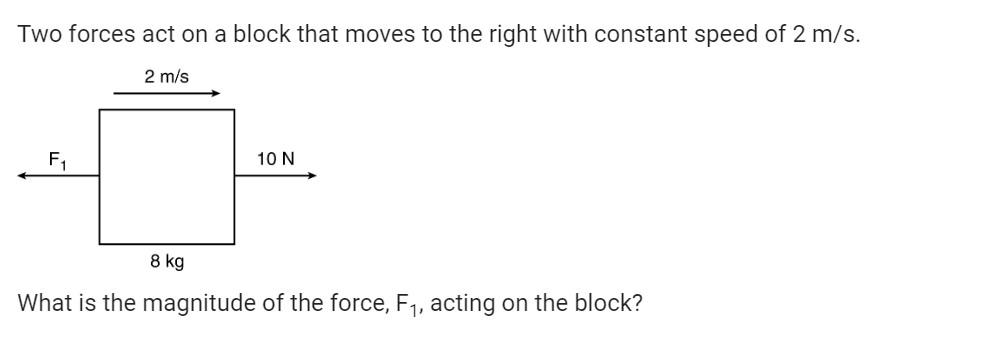What is the magnitude of the force, F1, acting on the block?

Understand the Problem
The question is asking for the magnitude of force F1 acting on a block that is moving at a constant speed, which indicates that the net force acting on the block is zero. Since one force is given (10 N), we can deduce the magnitude of F1 by using equilibrium principles.
Answer
The magnitude of the force $F_1$ acting on the block is $10 \, \text{N}$.
Answer for screen readers
The magnitude of the force $F_1$ acting on the block is $10 , \text{N}$.
Steps to Solve
- Identify the forces acting on the block
The block experiences two forces: $F_1$ acting to the left and 10 N acting to the right. Since the block moves at a constant speed, the forces must be balanced.
- Apply the equilibrium condition
In equilibrium, the sum of the forces acting on the block is zero. This can be expressed as:
$$ F_{\text{net}} = 0 = F_1 - 10 , \text{N} $$
- Rearrange the equation to solve for $F_1$
To find the magnitude of $F_1$, rearrange the equation:
$$ F_1 = 10 , \text{N} $$
- Conclude the value of the force
This gives us the magnitude of the force $F_1$.
The magnitude of the force $F_1$ acting on the block is $10 , \text{N}$.
More Information
In this case, since the block moves at a constant speed, it implies that the net force acting on it is zero, confirming that the forces are balanced. The friction force (which isn't mentioned) would also be included in a real scenario if applicable, but here we consider the net forces as stated.
Tips
- Ignoring the direction of forces: It's essential to note that one force is acting in one direction and the other in the opposite direction.
- Misunderstanding constant speed: Some might confuse constant speed with acceleration, but at constant speed, the net external force is zero.
AI-generated content may contain errors. Please verify critical information